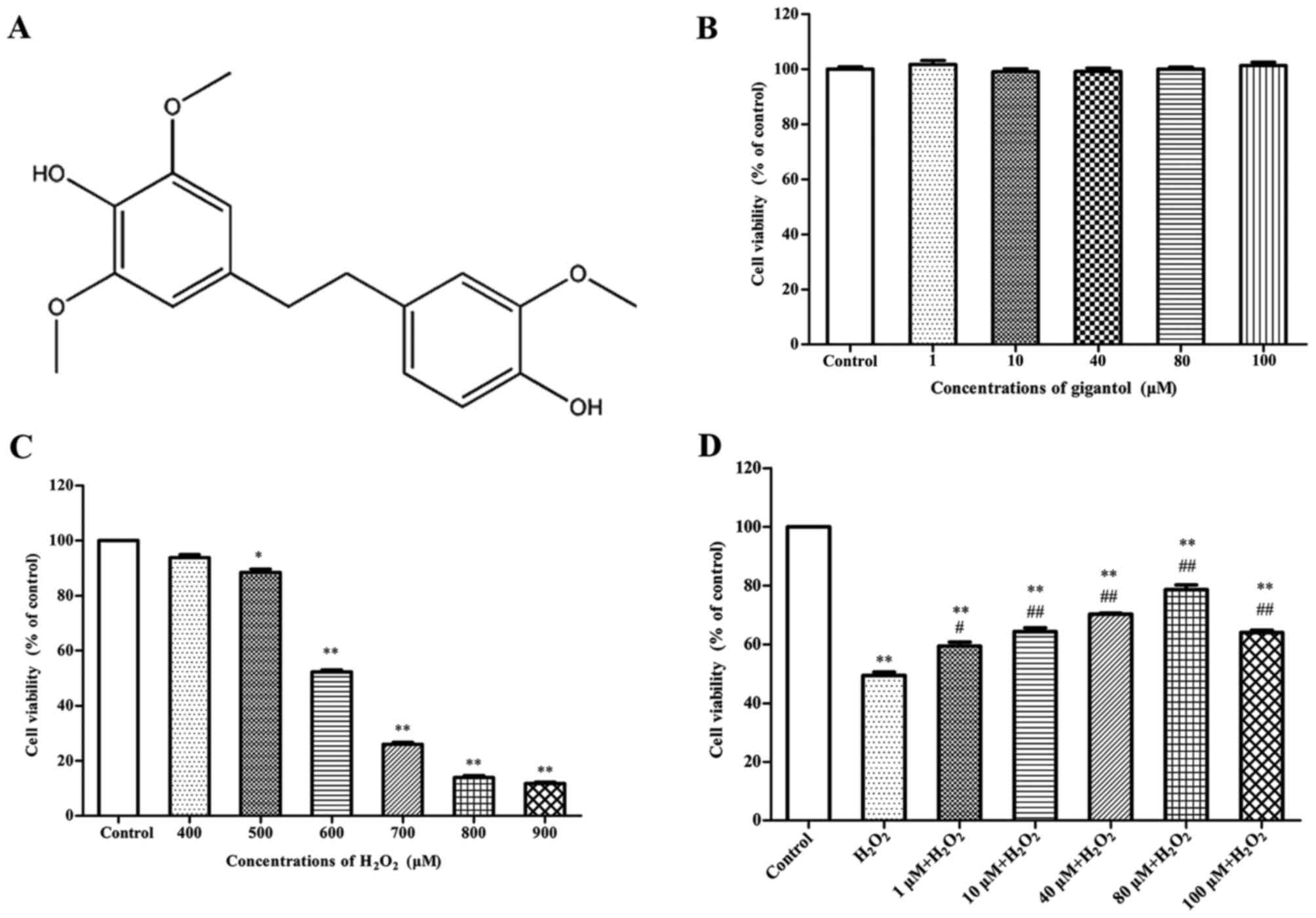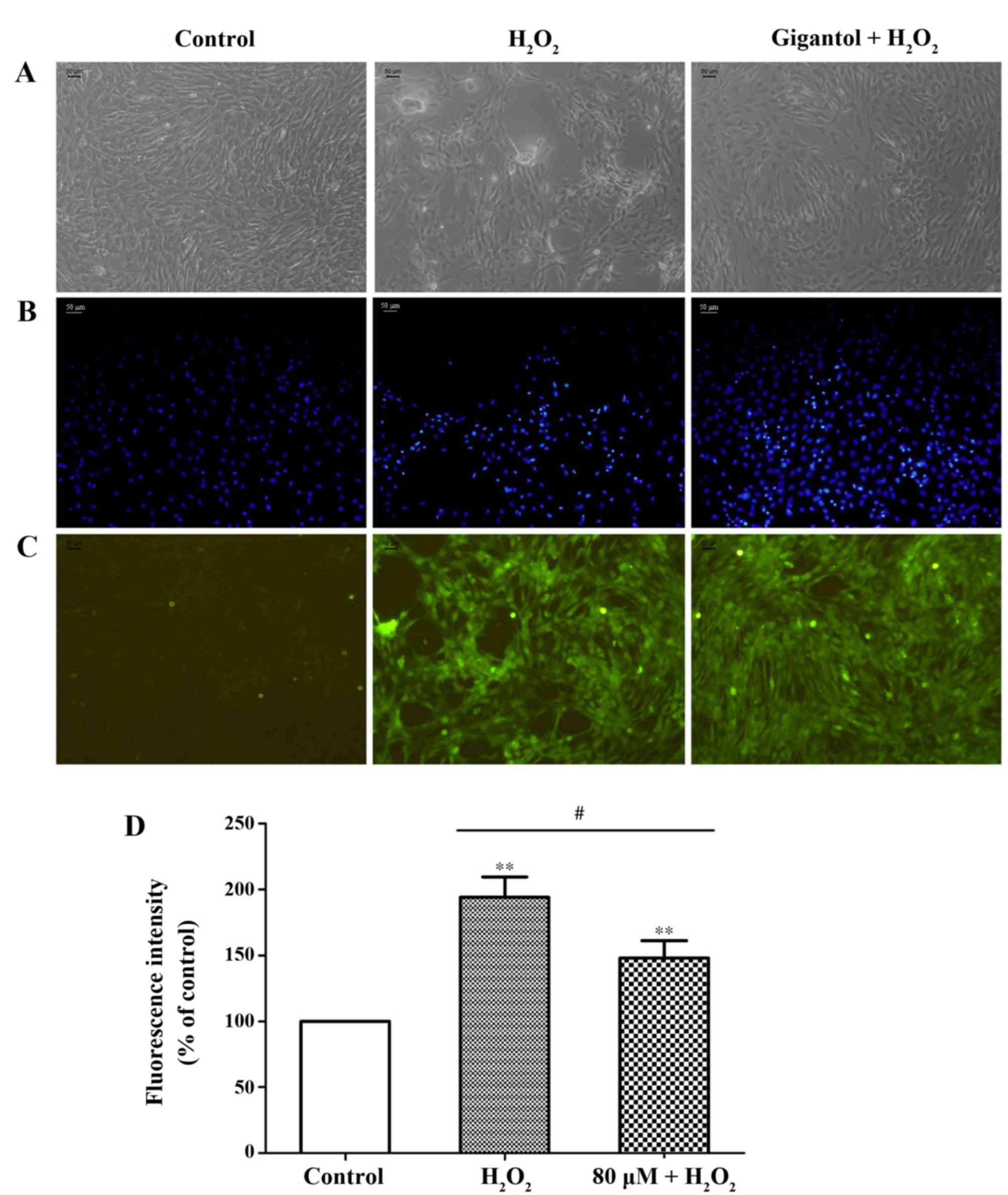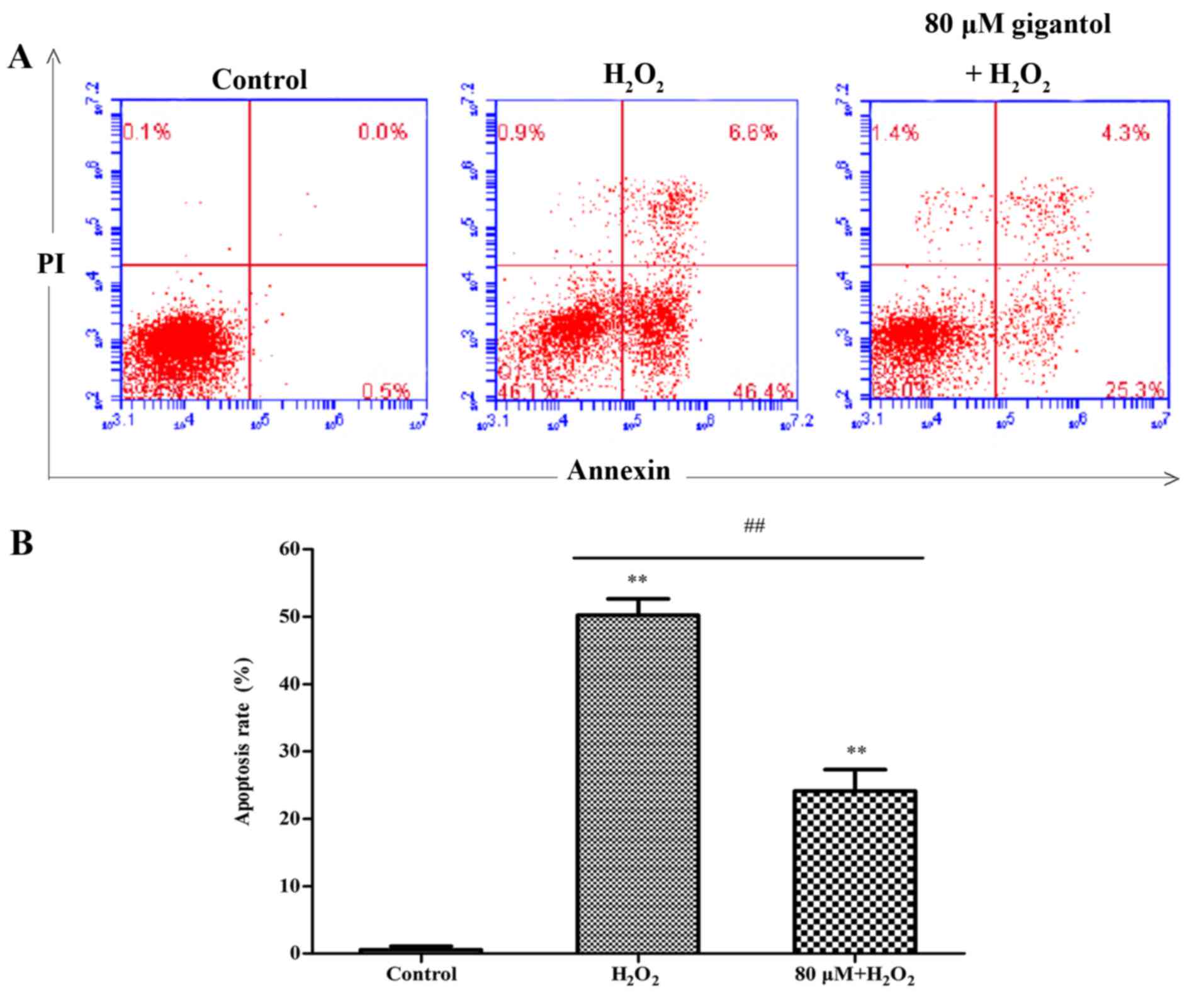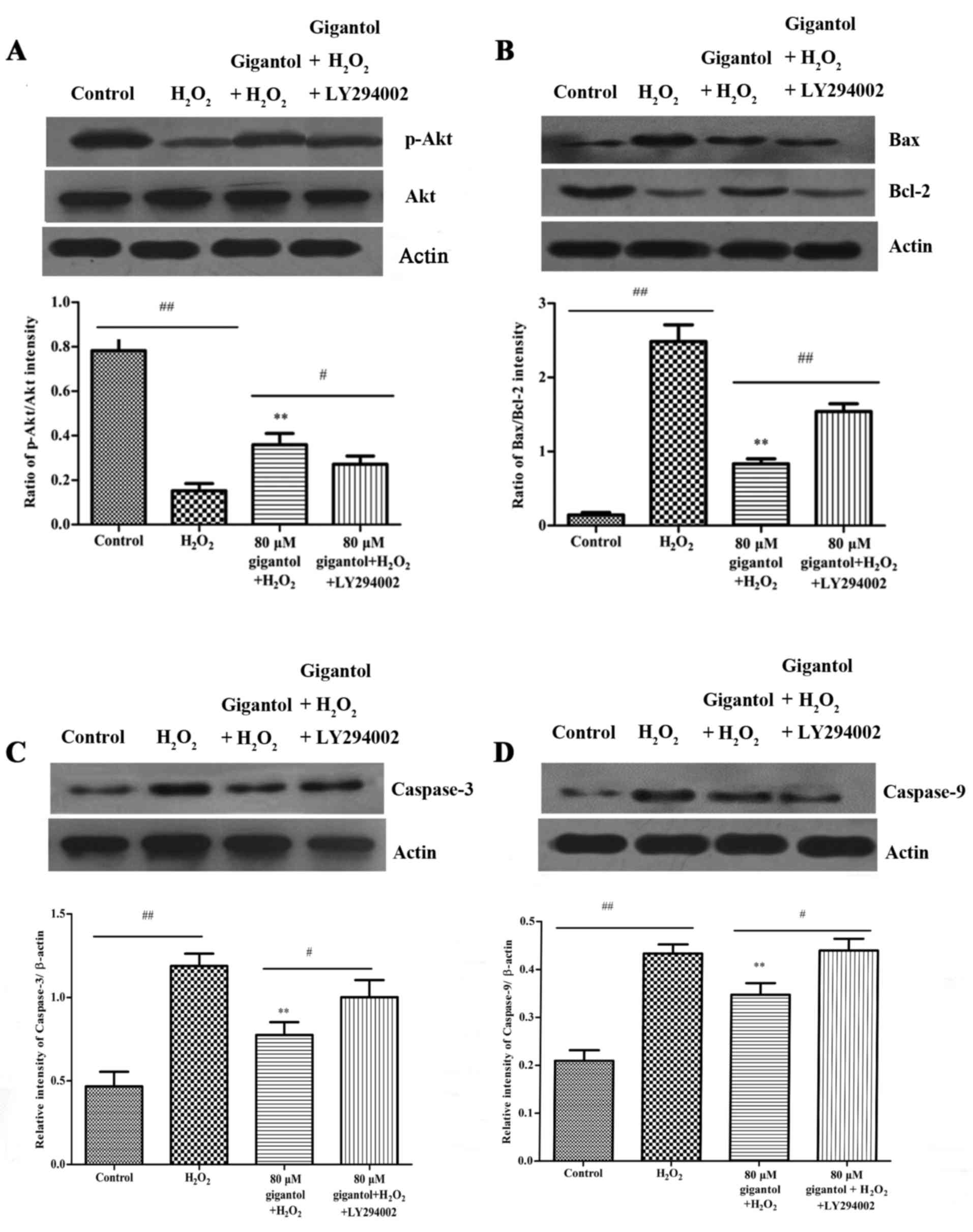Protective effect of gigantol against hydrogen peroxide‑induced apoptosis in rat bone marrow mesenchymal stem cells through the PI3K/Akt pathway
- Authors:
- Published online on: December 11, 2017 https://doi.org/10.3892/mmr.2017.8242
- Pages: 3267-3273
Abstract
Introduction
Diseases associated with cerebral ischemia are a major cause of mortality in developing countries. Ischemic stroke is associated with the acute loss of neurons, astroglia and oligodendroglia, in addition to disruption to synaptic architecture, as a result of cerebral artery occlusion (1). Certain studies have focused on the potential use of mesenchymal stem cell (MSC) transplantation in the treatment of central nervous system (CNS) diseases and injures, such as cerebral ischemia (2,3). MSC therapy is considered a novel and promising strategy for the treatment of ischemic stroke, and may exert neuroprotective effects and promote the repair of neurons by secreting various neural trophic factors and replacing damaged neurons (4). However, the ischemic microenvironment negatively influences the survival rate of transplanted MSCs in injured CNS conditions due to oxidative stress (5,6). Thus, improving the survival of MSCs during oxidative stress may improve the efficacy of MSC-based therapies.
Gigantol is a biphenolic compound that is primarily extracted from the stem of Dendrobium aurantiacum (7). Phenols derived from natural plants contain numerous antioxidants and therefore are typically used to study antioxidative activities (8–11). Furthermore, gigantol is reported to exhibit numerous biological functions, including anti-osmosis effects (12), antitumor effects in human liver (13) and lung (14) cancer, antimutagenic effects (15) and immunomodulatory activities (16). Additionally, gigantol was reported to be a potent compound for restoring sight in diabetics with cataracts (17). However, to the best of our knowledge, no previous studies have investigated the protective effect of gigantol on hydrogen peroxide (H2O2)-induced oxidative stress in rat bone marrow MSCs (rBMSCs). Therefore, the present study investigated whether gigantol protects against H2O2-induced oxidative stress in rBMSCs and whether the antioxidant mechanism of gigantol involves the phosphatidylinositol 3-kinase (PI3K)-protein kinase B (Akt) pathway.
Materials and methods
Chemicals and materials
Male 4-week-old Sprague-Dawley rats (n=10) weighing 80–100 g were used in the present study and were obtained from Guangzhou Laboratory Animal Center, Guangzhou University of Chinese Medicine (Guangzhou, China). Low glucose Dulbecco's modified Eagle's medium (DMEM) and PBS were acquired from Gibco (Thermo Fisher Scientific, Inc., Waltham, MA, USA). H2O2 was purchased from Guangzhou Chemical Reagent Factory (Guangzhou, China). Basal medium of Sprague-Dawley rat MSCs, fetal bovine serum (FBS), glutamine, penicillin-streptomycin and trypsin were purchased from Cyagen Biosciences, Inc. (Guangzhou, China). MTT and dimethyl sulfoxide were acquired from Sigma-Aldrich (Merck KGaA, Darmstadt, Germany). Gigantol was purchased from the National Institute for Food and Drug Control (cat. no. 111875; Beijing, China). The chemical structure of gigantol is presented in Fig. 1A. Annexin V-fluorescein isothiocyanate (FITC) apoptosis, Hoechst 33258 and reactive oxygen species (ROS) assay kits were provided by Nanjing KeyGen Biotech Co., Ltd. (Nanjing, China). The PI3K/Akt inhibitor LY294002 was purchased from Selleck Chemicals (Houston, TX, USA). All other chemicals were of analytical grade.
Isolation and culture of rBMSCs
MSCs were immediately isolated from the Sprague-Dawley rats as previously described, with minor modifications (18). Briefly, Sprague-Dawley rats were sacrificed by cervical dislocation. The experimental procedures were approved by the Laboratory Animal Committee of Guangdong Province (Guangzhou, China). All treatments on animals were performed in accordance with the Guide for the Care and Use of Laboratory Animals (19). The femurs and tibias of rats were carefully cleaned of adherent soft tissue, the marrow was harvested and flushed with serum-free DMEM with 1% penicillin-streptomycin until the bone washed pale. Cells were resuspended in DMEM medium with 10% FBS and 1% penicillin -streptomycin of Sprague-Dawley rBMSCs at 37°C with 5% CO2 After being allowed to attach for 24 h, hematopoietic and non-adherent cells were removed by changing the medium. Subsequently, rBMSCs were harvested for the experiments described below between the second and third passage. Cells were pretreated with gigantol for 12 h followed by treatment with H2O2 for 2 h, both at room temperature. To determine the effect of LY294002, cells were pretreated with LY294002 (25 µmol/l) for 1 h at room temperature, followed by the treatments with gigantol and H2O2.
Cell viability assay
Cells were seeded in 96-well plates (1×105 cells/ml) for 24 h at room temperature. To determine the effects of gigantol and H2O2 on rBMSC viability, cells were treated with 1, 10, 40, 80 and 100 µM gigantol for 12 h, or 400, 500, 600, 700, 800 and 900 µM H2O2 for 2 h, respectively. As a control, cells were treated with DMEM medium only. Furthermore, in another cell viability assay, cells were pretreated with different concentrations of gigantol (1, 10, 40, 80 and 100 µM) for 12 h followed by treatment with 600 µM H2O2 for 2 h, both at room temperature. Subsequently, 20 µl MTT was added to each well and incubated at 37°C for 4 h prior to removal and addition of 100 µl dimethyl sulfoxide. The absorbance value was measured in a microplate reader (Bio-Rad Laboratories, Inc., Hercules, CA, USA) at 490 nm. Statistical analysis was performed on absorbance value readings.
Assessment of morphological changes
Cells were cultured in 24-well plates (5×105 cells/well) and treated with 80 µM gigantol for 12 h followed by the addition of 600 µM H2O2 for 2 h. Cells in the H2O2 group were treated with 600 µM H2O2 only. Cells were fixed with 4% paraformaldehyde for 10 min and washed with PBS twice prior to staining with Hoechst 33258 for 5 min at 4°C in the dark. Condensed nuclei and cell shrinkage were observed using an inverted and fluorescence microscope (Leica Microsystems GmbH, Wetzlar, Germany). A bright blue stain indicated apoptotic cell nuclei.
Measurement of ROS
Cells were cultured in 6-well plates (1×106 cells/well) and treated with 80 µM gigantol for 12 h followed by the addition of 600 µM H2O2 for 2 h, both at room temperature. Cells in the H2O2 group were treated with 600 µM H2O2 only. Cells were stained with 10 µM 2′7′-dichlorofluorescin diacetate (DCFH-DA) diluted with serum-free medium at 37°C for 20 min and later washed with serum-free medium three times. Fluorescence intensity was analyzed using a microplate reader (Bio-Rad Laboratories, Inc.) at excitation and emission wavelengths of 488 and 525 nm, respectively. Images were captured using a fluorescence microscope (Leica Microsystems GmbH). The absorbance values were obtained for statistical analysis.
Flow cytometric analysis of cell apoptosis
Cells were seeded in 6-well plates (1×106 cells/well) for 24 h and and treated with 80 µM gigantol for 12 h followed by the addition of 600 µM H2O2 for 2 h. Cells in the H2O2 group were treated with 600 µM H2O2 only. Subsequently, cells were harvested and washed twice using PBS, and were resuspended in 500 µl binding buffer. Annexin V-FITC stock (5 µl) and propidium iodide solution (5 µl) was added to the cells and incubated for 10 min at room temperature in the dark, and immediately analyzed using flow cytometer (BD FACSCanto II). The percentage of apoptotic cells was obtained for statistical analysis.
Protein extraction and western blot analysis
Cells were seeded in 6-well plates (1×106 cells/well) for 24 h and treated with 80 µM gigantol for 12 h followed by the addition of 600 µM H2O2 for 2 h, both at room temperature. Cells in the H2O2 group were treated with 600 µM H2O2 only. Cells in the gigantol + H2O2 + LY294002 group were pretreated with LY294002 (25 µmol/l) for 1 h prior to gigantol with H2O2 treatment. Subsequently, cells were washed with PBS and lysed in cold radioimmunoprecipitation assay lysis buffer (Beyotime Institute of Biotechnology, Haimen, China) with protein inhibitor. Cellular proteins were collected and their concentrations were determined using a Bradford assay. Equal amounts of protein (40 µg/lane) were separated on 15% SDS-polyacrylamide gels and transferred onto polyvinylidene difluoride membranes via electrophoresis. After blocking with tris-buffered saline (TBS) containing 5% skimmed milk and 0.05% Tween-20 for 1 h at room temperature, the membranes were incubated with the following primary antibodies: p-Akt (ser 473; cat. no. Sc7985r; 1:100; Santa Cruz Biotechnology, Inc., Dallas, TX, USA), Akt (ser 473; cat. no. Sc8312; 1:200; Santa Cruz Biotechnology, Inc.), B-cell lymphoma-2 (Bcl-2)-associated X (Bax; cat. no. 2772; 1:1,000; CST Biological Reagents Co., Ltd., Shanghai, China), Bcl-2 (cat. no. 2872; 1:1,000; CST Biological Reagents Co., Ltd.), Caspase-3 (cat. no. 9662; 1:1,000; CST Biological Reagents Co., Ltd.), Caspase-9 (cat. no. 9504; 1;1,000; CST Biological Reagents Co., Ltd.) and β-actin (cat. no. sc58673; Santa Cruz Biotechnology, Inc.) at 4°C overnight. After washing with TBS three times, the membranes were incubated with goat anti-rabbit immunoglobulin G antibodies conjugated with horseradish peroxidase (cat. no. 111-035-003; 1:1,000; Jackson Immuno Research Laboratories, Inc., West Grove, PA, USA) for 1 h at room temperature. Following three washes with TBS-Tween-20, the intensity of bands was visualized using an enhanced chemiluminescence western blotting kit (Merck KGaA) and quantified by densitometric analysis with ImageJ software (version 3.0; National Institutes of Health, Bethesda, MD, USA).
Statistical analysis
All experiments were conducted at least three times. Data are presented as the mean + standard error of the mean. Differences among groups were analyzed by one-way analysis of variance, followed by Dunnett's post-hoc test, using SPSS version 20 (IBM Corp., Armonk, NY, USA). P<0.05 was considered to indicate a statistically significant difference.
Results
Gigantol inhibits H2O2-induced inhibition of cell viability in rBMSCs
To determine an appropriate concentration of gigantol, cells were treated with gigantol (1, 10, 40, 80 and 100 µM), and the results indicated that none of these concentrations exhibited a damaging effect on cell viability (Fig. 1B). Cell viability was reduced in a dose-dependent manner when treated with 400, 500, 600, 700 and 800 µM H2O2 for 2 h, compared with the control group. H2O2 at the concentration of 600 µM significantly reduced cell viability compared with the control by 51.6±3.2% (Fig. 1C). In addition, results in Fig. 1D demonstrated that gigantol significantly increased the cell viability of rBMSCs in a dose-dependent manner compared with cells treated with H2O2 only. Furthermore, pretreatment with 80 µM gigantol significantly enhanced cell viability compared with the H2O2 only group (Fig. 1D). Concentrations of gigantol >80 µM reduced the stimulatory effect. Therefore, 600 µM H2O2 and 80 µM gigantol were selected for the following experiments.
Assessment of morphological changes
Following treatment with H2O2, apoptosis-associated morphology was observed in rBMSCs, including detachment, irregular shape and nuclear shrinkage. However, the number of apoptosis-like cells decreased in the group pretreated with gigantol, which indicated a potential protective effect of gigantol from apoptosis induction (Fig. 2A and B).
Detection of ROS
Cellular oxidative stress was examined by a DCFH-DA assay. The results demonstrated that, in the H2O2-treated group, a significant increase in 2′,7′-dichlorofluorescein fluorescence was observed (Fig. 2C and D). However, pretreatment with gigantol significantly reduced the intracellular production of ROS compared with the H2O2-treated group (Fig. 2C and D).
Analysis of cell apoptosis
Cell apoptosis was analyzed using an Annexin V and propidium iodide double-staining assay by flow cytometry. The percentage of apoptotic cells in Q2 and Q4 increased from 0.5±0.45% in the control group to 49.5±3.30% in the H2O2 group, while apoptosis was significantly reduced to 23.4±2.06% in the gigantol + H2O2 group, compared with the H2O2 only group (Fig. 3).
Gigantol activates the PI3K/Akt pathway
The results of western blot analysis demonstrated that H2O2 treatment reduced the protein levels of phosphorylated (p)-Akt and the antiapoptotic protein Bcl-2 (Fig. 4A and B), and increased the levels of the proapoptotic proteins Bax, caspase-3 and caspase-9 (Fig. 4B-D). However, gigantol pretreatment lowered the caspase-3, caspase-9 and Bax levels, and increased the levels of p-Akt and Bcl-2, compared with the H2O2 only group (Fig. 4). Furthermore, LY294002 (a PI3K inhibitor) significantly inhibited the protective effect of gigantol against H2O2-induced apoptosis by increasing the levels of caspase-3, caspase-9 and the ratio of Bax/Bcl-2, and decreasing the ratio of p-Akt/Akt (Fig. 4).
Discussion
Previous studies have reported that the transplantation of human or rat MSCs led to a substantial functional improvement in stroke treatment (20–22). However, the low survival rate of MSCs that are transplanted for the treatment of an ischemic myocardium indicates that the hypoxic microenvironment may impair the survival of MSCs. H2O2 has successfully been used to induce oxidative stress, which led to cell apoptosis and mimicked the hypoxic microenvironment of the ischemic brain (23–25). In addition, Sun et al (26) employed a H2O2-induced cytotoxicity model of BMSCs to investigate damage induced by oxidative stress.
We previously reported that gigantol is abundant in Dendrobium aurantiacum among the herbal medicines grouped as Huangcao Shihu, which includes Dendrobium nobile, Dendrobium fimbriatum and Dendrobium aurantiacum (27). It is uncommon for such high concentrations of active compounds to occur naturally within plants; therefore, gigantol may be of clinical value if beneficial effects are observed. The present study, to the best of our knowledge, is the first to indicate that gigantol may have protective activities against ischemic diseases, as MTT and flow cytometry results demonstrated that gigantol inhibited H2O2-induced cell apoptosis in rBMSCs. Furthermore, gigantol reduced the generation of ROS in H2O2-treated rBMSCs, which indicates that gigantol may exhibit beneficial antiapoptotic activities through inhibition of ROS generation.
A previous report demonstrated that extracellular H2O2 enhanced intracellular concentrations of ROS, which subsequently inactivated p-Akt (28). In the present study, treatment of MSCs with H2O2 led to decreased levels of p-Akt, indicating that the PI3K/Akt signaling pathway may be inhibited in MSCs following exposure to H2O2. In the present study, treatment with gigantol activated the expression of p-Akt in H2O2-induced rBMSCs. Previous studies have demonstrated that the PI3K/Akt pathway is involved in various biological processes, including cell growth, survival and apoptosis, and also has roles in cell metabolism, proliferation and migration (29–31).
PI3K/Akt is reported to prevent cell apoptosis by reducing the expression of various proapoptotic proteins, including caspase-3, caspase-9 and Bax, and by elevating the levels of the antiapoptotic protein Bcl-2 (32). These results are consistent with those of an earlier report, which indicated that PI3K-Akt signaling increased the intracellular levels of ROS and activated the proapoptotic proteins caspase-3, caspase-9 and Bax, and inhibited the expression of Bcl-2 (33). The results of the current study demonstrated that H2O2 treatment increased the Bax/Bcl-2 ratio, and caspase-3 and caspase-9 protein expression, in rBMSCs. However, pretreatment with gigantol suppressed the Bax/Bcl-2 ratio, and caspase-3 and caspase-9 levels, which indicates that gigantol may protect against rBMSC apoptosis via the PI3K/Akt signaling pathway. Furthermore, LY294002, a specific PI3K/Akt inhibitor, blocked the protective effects of gigantol. These results confirmed that PI3K/Akt may be activated by gigantol to protect rBMSCs from H2O2-induced apoptosis.
In conclusion, the present study demonstrated that gigantol significantly inhibited H2O2-induced apoptosis in rBMSCs. The protective effect of gigantol was accompanied by reductions in intracellular ROS generation, the expression ratio of Bax/Bcl-2, and caspase-3 and caspase-9 protein expression, in addition to increases in the ratio of p-Akt/Akt and Bcl-2 expression. Therefore, gigantol may have the potential to be developed as a protective agent for the clinical treatment of patients with ischemic diseases. Regarding the utilization of gigantol in ischemic stroke, however, further in vitro and in vivo experiments are required to investigate the effect of gigantol on transport and differentiation in rBMSCs.
Acknowledgements
The present study was financially supported by the Special Foundation of 2015 High Level University Construction (grant no. 2050205), the Special Foundation of High Level University Construction of Guang Zhou University of Chinese Medicine (grant no. A1-AFD018171Z11024) and the Science and Technology Planning Project of Guangdong Province (grant no. 2013B060400022).
Glossary
Abbreviations
Abbreviations:
|
rBMSCs |
rat bone marrow mesenchymal stem cells |
|
Bcl-2 |
B-cell lymphoma-2 |
|
Bax |
Bcl-2-associated X |
|
H2O2 |
hydrogen peroxide |
|
PI3K |
phosphatidylinositol 3-kinase |
|
Akt |
protein kinase B |
|
ROS |
reactive oxygen species |
References
|
Tuan RS, Boland G and Tuli R: Adult mesenchymal stem cells and cell-based tissue engineering. Arthritis Res Ther. 5:32–45. 2003. View Article : Google Scholar : PubMed/NCBI | |
|
De Keyser J: Autologous mesenchymal stem cell transplantation in stroke patients. Ann Neurol. 58:653–654. 2005. View Article : Google Scholar : PubMed/NCBI | |
|
Monsel A, Zhu YG, Gennai S, Hao Q, Liu J and Lee JW: Cell-based therapy for acute organ injury: Preclinical evidence and ongoing clinical trials using mesenchymal stem cells. Anesthesiology. 121:1099–1121. 2014. View Article : Google Scholar : PubMed/NCBI | |
|
Hao L, Zou Z, Tian H, Zhang Y, Zhou H and Liu L: Stem cell-based therapies for ischemic stroke. Biomed Res Int. 2014:4687482014. View Article : Google Scholar : PubMed/NCBI | |
|
Lee JH, Jung HK, Han YS, Yoon YM, Yun CW, Sun HY, Cho HW and Lee SH: Antioxidant effects of Cirsium setidens extract on oxidative stress in human mesenchymal stem cells. Mol Med Rep. 14:3777–3784. 2016. View Article : Google Scholar : PubMed/NCBI | |
|
Wei H, Li Z, Hu S, Chen X and Cong X: Apoptosis of mesenchymal stem cells induced by hydrogen peroxide concerns both endoplasmic reticulum stress and mitochondrial death pathway through regulation of caspases, p38 and JNK. J Cell Biochem. 111:967–978. 2010. View Article : Google Scholar : PubMed/NCBI | |
|
Li Y, Wang ZT and Xu LS: Phenols and a triterpene from Dendrobium aurantiacum var. Denneanum (Orchidaceae). Biochem Syst Ecol. 34:658–660. 2006. View Article : Google Scholar | |
|
Kuppusamy S, Thavamani P, Megharaj M, Nirola R, Lee YB and Naidu R: Assessment of antioxidant activity, minerals, phenols and flavonoid contents of common plant/tree waste extracts. Ind Crop Prod. 83:630–634. 2016. View Article : Google Scholar | |
|
Wang ST, Gao W, Fan YX, Liu XG, Liu K, Du Y, Wang LL, Li HJ, Li P and Yang H: Phenol profiles and antioxidant capacities of bistort rhizoma (Polygonum bistorta L.) extracts. Rsc Adv. 6:27320–27328. 2016. View Article : Google Scholar | |
|
Temel E, Alasalvar C, Gokce H, Güder A, Albayrak Ç, Alpaslan YB, Alpaslan G and Dilek N: DFT calculations, spectroscopy and antioxidant activity studies on (E)-2-nitro-4-((phenylimino)methyl)phenol. Spectrochim Acta A. 136:534–546. 2015. View Article : Google Scholar | |
|
Menshchikova EB, Wisman NY, Zenkov NK, Tkachev VO and Kandalintseva NV: ARE-inducing phenol antioxidant TC-13 improves survival of drosophila melanogaster in oxidative stress. B Exp Med. 154:260–264. 2012. View Article : Google Scholar | |
|
Fang H, Hu X, Wang M, Wan W, Yang Q, Sun X, Gu Q, Gao X, Wang Z, Gu L, et al: Anti-osmotic and antioxidant activities of gigantol from Dendrobium aurantiacum var. Denneanum against cataractogenesis in galactosemic rats. J Ethnopharmacol. 172:238–246. 2015. View Article : Google Scholar : PubMed/NCBI | |
|
Chen H, Huang Y, Huang J, Lin LZ and Wei G: Gigantol attenuates the proliferation of human liver cancer through the PI3K/Akt/NF-κB signaling pathway. Oncol Rep. 37:865–870. 2017. View Article : Google Scholar : PubMed/NCBI | |
|
Bhummaphan N and Chanvorachote P: Gigantol suppresses cancer stem cell-like phenotypes in lung cancer cells. Evid Based Complement Alternal Med. 2015:1–10. 2015. View Article : Google Scholar | |
|
Miyazawa M, Shimamura H, Nakamura S and Kameoka H: Antimutagenic activity of gigantol from Dendrobium nobile. J Agrc Food Chem. 45:2849–2853. 1997. View Article : Google Scholar | |
|
Won JH, Kim JY, Yun KJ, Lee JH, Back NI, Chung HG, Chung SA, Jeong TS, Choi MS and Lee KT: Gigantol isolated from the whole plants of cymbidium goeringii inhibits the LPS-induced iNOS and COX-2 expression via NF-κB inactivation in RAW 264.7 macrophages cells. Planta Med. 72:1181–1187. 2006. View Article : Google Scholar : PubMed/NCBI | |
|
Wu J, Lu C, Li X, Fang H, Wan W, Yang Q, Sun X, Wang M, Hu X, Chen CY and Wei X: Synthesis and biological evaluation of novel gigantol derivatives as potential agents in prevention of diabetic cataract. PLoS One. 10:e01410922015. View Article : Google Scholar : PubMed/NCBI | |
|
Tropel P, Noël D, Platet N, Legrand P, Benabid AL and Berger F: Isolation and characterisation of mesenchymal stem cells from adult mouse bone marrow. Exp Cell Res. 295:395–406. 2004. View Article : Google Scholar : PubMed/NCBI | |
|
National Research Council (US) Committee for the Update of the Guide for the Care and Use of Laboratory Animals: Guide for the Care and Use of Laboratory Animals. 8th. National Academies Press (US); Washington, DC: 2011 | |
|
Gutiérrez-Fernández M, Rodríguez-Frutos B, Ramos-Cejudo J, Teresa Vallejo-Cremades M, Fuentes B, Cerdán S and Díez-Tejedor E: Effects of intravenous administration of allogenic bone marrow- and adipose tissue-derived mesenchymal stem cells on functional recovery and brain repair markers in experimental ischemic stroke. Stem Cell Res. 4:112013. View Article : Google Scholar | |
|
Wei L, Fraser JL, Lu ZY, Hu X and Yu SP: Transplantation of hypoxia preconditioned bone marrow mesenchymal stem cells enhances angiogenesis and neurogenesis after cerebral ischemia in rats. Neurobiol Dis. 46:635–645. 2012. View Article : Google Scholar : PubMed/NCBI | |
|
Tsai LK, Wang Z, Munasinghe J, Leng Y, Leeds P and Chuang DM: Mesenchymal stem cells primed with valproate and lithium robustly migrate to infarcted regions and facilitate recovery in a stroke model. Stroke. 42:2932–2939. 2011. View Article : Google Scholar : PubMed/NCBI | |
|
Lin YC, Huang YC, Chen SC, Liaw CC, Kuo SC, Huang LJ and Gean PW: Neuroprotective effects of ugonin K on hydrogen peroxide-induced cell death in human neuroblastoma SH-SY5Y cells. Neurochem Res. 34:923–930. 2009. View Article : Google Scholar : PubMed/NCBI | |
|
Zhang Q, Huang WD, Lv XY and Yang YM: Puerarin protects differentiated PC12 cells from H2O2-induced apoptosis through the PI3K/Akt signalling pathway. Cell Biol Int. 36:419–426. 2012. View Article : Google Scholar : PubMed/NCBI | |
|
Lee AY, Wu TT, Hwang BR, Lee J, Lee MH, Lee S and Cho EJ: The neuro-protective effect of the methanolic extract of Perilla frutescens var. Japonica and rosmarinic acid against H2O2-induced oxidative stress in C6 glial cells. Biomol Ther (Seoul). 24:338–345. 2016. View Article : Google Scholar : PubMed/NCBI | |
|
Sun B, Feng M, Tian X, Lu X, Zhang Y, Ke X, Huang S, Cao J and Ding X: Dl-3-n-Butylphthalide protects rat bone marrow stem cells against hydrogen peroxide-induced cell death through antioxidation and activation of PI3K-Akt pathway. Neurosci Lett. 516:247–252. 2012. View Article : Google Scholar : PubMed/NCBI | |
|
Tao SC, Chen ZH, Huang KW, Yan MX and Wei G; Guangzhou University of Chinese Medicine, ; Foshan Hospital of Traditional Chinese Medicine Affiliated to Guangzhou University of Chinese Medicine, : Comparative study of HPLC characteristic spectrum of Dendrobium fimbriatum hook and other huangcao dendrobium species. Chin Med Phar. 27:238–241. 2016. | |
|
Li Y, Xue F, Xu SZ, Wang XW, Tong X and Lin XJ: Lycopene protects bone marrow mesenchymal stem cells against ischemia-induced apoptosis in vitro. Eur Rev Med Pharmaco. 18:1625–1631. 2014. | |
|
Stambolic V and Woodgett JR: Functional distinctions of protein kinase B/Akt isoforms defined by their influence on cell migration. Trends Cell Bio. 16:461–466. 2006. View Article : Google Scholar | |
|
Osaki M, Oshimura M and Ito H: PI3KAkt pathway: Its functions and alterations in human cancer. Apoptosis. 9:667–676. 2004. View Article : Google Scholar : PubMed/NCBI | |
|
Song G, Ouyang G and Bao S: The activation of Akt/PIK13 signaling pathway and cell survival. J Cell Mol Med. 9:59–71. 2005. View Article : Google Scholar : PubMed/NCBI | |
|
Downward J: PI 3-kinase, Akt and cell survival. Semin Cell Dev Biol. 15:177–182. 2004. View Article : Google Scholar : PubMed/NCBI | |
|
Kim JY, Lee JS, Han YS, Lee JH, Bae I, Yoon YM, Kwon SM and Lee SH: Pretreatment with lycopene attenuates oxidative stress-induced apoptosis in human mesenchymal stem cells. Biomol Ther. 23:517–524. 2015. View Article : Google Scholar |













